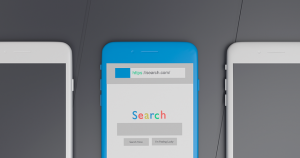When the time comes to implement a website redesign, one trend you’ll hear pop up over and over again is responsive design. But you shouldn’t design with responsive design in mind because it’s a hot new trend. You should design with it in mind because it’s the best thing you can do for your digital marketing strategy.

Responsive design reflects a new way of doing business online. It’s a direct result of the increase in web surfing technologies, from various-sized laptop monitors to tablets and iPhones. And regardless of your industry, it’s a must-have when you tackle a new outsourced website design project. Here are three important reasons why.
#1. Responsive Design Lets You Prioritize Information Accessibility
At its heart, responsive design is a natural progression of how we digest information online. After all, the primary purpose of a website is to provide information to your customers, whether that’s in the form of your brick and mortar business information, blog posts, or premium content downloads.
Without responsive design, your website shows as much of a website as possible, regardless of how important that information is. This often leads to users dropping in on a website and not being able to find the information they’re looking for. Just how likely do you think a customer will be to work with you or buy from you if you force them to spend five minutes zooming in and out to avoid a screenful of your logo?
Maximize it: When designing your website, make sure each widget or block of information is appropriately prioritized. This will help keep the important information (your text-based physical location information, for example) towards the top of the website no matter what the size of the device.
#2. Responsive Design Speaks to Different Demographics
Whether you’re looking to speak to millennials in particular or not, the demographics of mobile and tablet traffic are uniquely appealing across the board. Sixty-three percent of adult cell owners use their phones to go online, and 34 percent go online mostly using their phones, not using another device such as a desktop or laptop computer.
Maximize it: Design your responsive website with your target audience in mind. If you’re looking to make the most of millennials who access your site, focus on a fluid and interactive user experience. If you’re looking to connect with older audiences, focus on larger text and traditional images. Using your metrics to help you make high-level decisions about your website design will help you create the most effective website possible.
#3. Responsive Design Capitalizes on Meaningful Trends.
Responsive design is also important in that it provides context for the important metrics and trends you capture from your site visitors. Without the context of how and why your prospective customers access your website, you won’t be able to target your digital marketing efforts effectively.
For example, 58 percent of adults own a smartphone and 42 percent of adults own a tablet. Based on those numbers alone, you might be tempted to target your website strategy to mobile users. But unless you track how much traffic you actually get from mobile devices, the fact that tablet recently surpassed mobile in overall web traffic could derail your strategy.
Maximize it: Install a responsive design website, but also pay attention to key performance indicators and metrics. The information you get — including heat map clicks and downloads — all provide important data about your customers and what they want to get out of your website.
Responsive design is becoming a common best practice for good reason. It’s the only way to make sure your company’s information is presented in a controlled and targeted way no matter how a prospective customer chooses to visit your site. If you want to get the most ROI out of your website and your digital marketing strategy, you’ll want to make sure responsive design is on your must-have redesign list.
Business Articles | Business 2 Community
(424)










